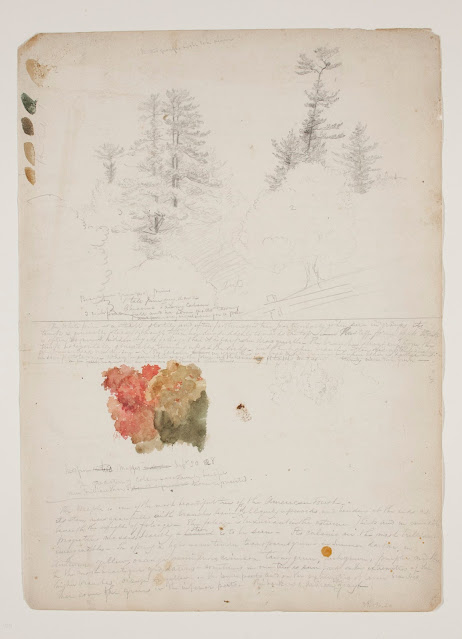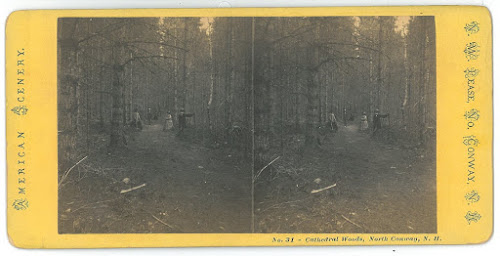Last week we received an incredible donation from Noel Quinton of over one-hundred postcards. It is a magnificently rich collection, full of potential stories that will help us unlock some of our local history mysteries. Here is the first of many more tales to come. This one attempts to map out a lost trail to a misplaced tourist attraction.
We start with this postcard from our new collection of a large tree labelled horizontally at the top right "The Wizard Birch, Intervale N.H." Along the right edge of the image it reads vertically "Copyrighted by N. Weston Pease, North Conway, N.H. 1577" (click on the image to enlarge it).
In her Cow Hampshire blog (here), Janice Brown traced the tree's history and asked the question "where is it now?" (or more precisely where was it?) The obvious answer would seem to be in Intervale N.H. as noted on the postcard above, but it is harder to track down Intervale that it might first seem. The question is "which intervale?" There are several places with that name in the area.
According to this website, Intervale is a village that spans two towns, Conway and Bartlett. The Intervale post office (zip code 03845) is in Conway. Here is a Google satellite view showing that "Intervale."
To make it more confusing, all of the low lands on both sides of the Saco River are called intervales.
This use of the term can be seen here in Jeremy Belknap's 1792 History of New Hampshire and another postcard from the new donation helps illustrate the viewpoint. This is basically the same view you can see now from the Intervale scenic vista rest area.
The Cow Hampshire blog has another clue that may help. Janice includes a photo of the tree from the Library of Congress with the caption "Cathedral woods, Intervale, White Mountains; Detroit Publishing Company, 6 December 1900."
However, once again we have a problem - which Cathedral woods? There were at least two in the area.
By coincidence we have a similar photo (without the people) on display in the history hall by the same company and the same year 1900 (which by coincidence was also the year the library's construction where that date is literally written in stone and more recently steel. For more on that see our previous blog here).
In a previous blog,
we focused on the poster on the left of Cathedral Ledge located on the west side of the Saco River rising out of what is now called Cathedral Woods. Now we will
move our attention down the hall to the next image on the left wall, in
the hallway leading to the Henney History Room to an earlier Cathedral
Woods on the east side of the Saco River, literally over the river and through the woods from the first. (we will map this out and try to explain that below).
Here is a closer view of that image.
At the bottom left it reads "015104. THE WIZARD TREE, CATHEDRAL WOOD, INTERVALE, WHITE MOUNTAINS"
Details on the original copyright for that photo can be found here.
On the bottom right it reads "COPYRIGHT 1900 BY DETROIT PHOTOGRAPHIC CO."
On the left on the map above can be seen the road leading to Cathedral Ledge. The woods at the base of the ledge are now known as Cathedral Woods. However the older Cathedral Woods were over at the top right in Intervale.
John Cannell who lived in the area and remembered the location of the tree sketched a map on the back of our photo. It locates the tree close to the Intervale train station near the Abenaki Gift Shop.
While the Intervale train station has been moved away and now serves as a residence, the area can be identified by nearby buildings and other physical remains of the past.
This postcard can be found on the Bartlett Historical Society
here along with some relevant information.
Here is that view today.
The station sign still stands.
And the train still passes by.
Pease also did a stereoview photograph labelled Cathedral Woods...
... as well as a later colorized postcard of Cathedral Woods.
Here is another Pease postcard entitled Cathedral Woods, Intervale, N.H.
We know this was the Cathedral Woods on the east side of the Saco as the titles locate it in Intervale. Also period photos show that what today is called Cathedral Woods (on the west side of the Saco) had been clear cut during that time, so there were no woods there.
To add even more to the mystery, the new donation also includes the following post cards with similar, but not identical scenes, entitled "Enchanted Woods, North Conway, N.H."
Below is another "Enchanted Woods."
So is enchanted woods the same as the early cathedral woods? Let's turn to another photographer of the Wizard Birch, T.E.M White.
Both Pease and White ran ads in the The White Mountain Echo newspaper (August 27, 1881 p. 14).
Here is a detail of the ads (seen in the red box above).
Note the last two lines of White's ad "House on the edge of the "Enchanted Woods," adjacent to the Indian Tent."
You can see the locations of both the White and Pease studios on the map below from another issue of The White Mountain Echo (click on image to enlarge it).
You can find a short bio on Pease here showing his house where Joe Jones is now across from the North Conway Public Library he worked so hard to develop (click on image to enlarge it).
For more information on this wonderful collection contact us at the Conway Public Library's Henney History Room.





































